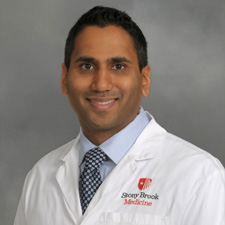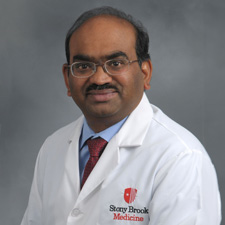Navigating the complexities of sarcoma, a rare but impactful group of cancers, can be challenging, especially when first confronting a diagnosis. In 2024, over 13,500 new soft tissue sarcomas and almost 4,000 bone sarcomas are expected to be diagnosed in the United States, according to the American Cancer Society.
While there are challenges in treating sarcoma, being treated by experts is the most effective approach. When a patient is evaluated and cared for by a team of high-level specialists in this specific type of cancer, the individual receives a precise diagnosis, tailored care, personalized treatment plans and full support throughout the healthcare process.
Defining sarcoma
Sarcoma is the term used for tumors that occur in the bones or connective tissues of the body. They are relatively rare, accounting for less than one percent of all solid cancers. Some soft tissue tumors are not cancerous and are called benign.
Unlike more common cancers, which typically start in organs like the lungs or breasts, soft tissue sarcomas develop in the supportive tissues surrounding body structures, including muscle, tendons, nerves, fat and blood vessels. These cancers can occur anywhere in the body but are common in the arms, legs, chest and abdomen.
All ages can be affected by sarcoma
Sarcomas can affect individuals of all ages, from children to adults. Soft tissue sarcomas are common in people aged 65 or older. In most cases, sarcomas may arise spontaneously, while, much more rarely, they are linked to genetic factors or pre-existing conditions.
Most diagnosed sarcomas are malignant (cancerous) soft tissue tumors, which are more prevalent in adults. Malignant bone tumors make up just over 10 percent of sarcomas, and they are the most common among children.
Some types of sarcomas that are diagnosed in adults:
- Liposarcoma. Begin in the fatty tissues of the limbs, especially the thigh, and the abdomen.
- Undifferentiated Pleomorphic Sarcoma (UPS). A rare type of cancer that begins mostly in the soft tissues of the body. Soft tissues connect, support and surround other body structures. UPS usually occurs in the arms or legs. Less often it can happen in the area behind the abdominal organs (retroperitoneum).
- Leiomyosarcoma (LMS). A type of rare cancer that grows in the smooth muscles, which are in the hollow organs of the body, including the intestines, stomach, bladder and blood vessels. In females, there is also smooth muscle in the uterus.
- Fibrosarcoma. A very rare tumor that begins in the fibrous connective tissue that wraps around the tendons, ligaments and muscles.
- Dermatofibrosarcoma Protuberans. A rare type of skin cancer that most often begins in connective tissue cells in the middle layer of the skin.
Some types of sarcomas that are diagnosed in children:
- Osteosarcoma. The most common primary bone sarcoma in children, often occurring around the knee and the shoulder, but potentially in any skeletal site.
- Ewing’s Sarcoma. The second most common primary bone sarcoma in children.
- Rhabdomyosarcoma. The most common soft tissue sarcoma in children.
- Synovial Sarcoma. A rare type of soft tissue sarcoma most often found in pediatric patients and young adults.
Challenges in treatment
Sarcomas pose unique challenges in treatment due to their rarity and various types. Sarcomas vary widely in their characteristics, which has always made it difficult to develop a universal treatment approach. To address this, doctors tailor treatments to the sarcoma’s specific subtype, location and stage.
Additionally, sarcomas are often close to vital structures in the body, such as nerves and blood vessels, making surgical interventions more challenging. Together, these factors contribute to the complexity of sarcoma treatment and highlight the importance of consulting with a healthcare team experienced in managing these unique cancers for the best possible outcomes.
Doctors with the right expertise
When a primary doctor notices the signs of soft tissue sarcoma, such as on a suspicious MRI scan, the patient is referred to a cancer doctor, called an oncologist. Soft tissue sarcoma is rare and best treated by someone with experience in these types of cancer. Because sarcomas are so uncommon, doctors who specialize in soft tissue cancers are often found within an academic or specialized cancer center, such as Stony Brook Cancer Center.
At Stony Brook Cancer Center, the teams specialize in rare types of sarcomas with an interdisciplinary approach.
Orthopedic oncologists specialize in bone and soft tissue tumors, making them well-suited to address sarcomas located in these areas.

"In orthopedic oncology, we now have updated tools, techniques and materials that give our patients the best possible outcomes and quality of life,” said Fazel Khan, MD, Chief, Orthopedic Oncology at Stony Brook Cancer Center. “By working as a team and collaborating with other experts in cancer services, our patients are ensured, not only the most accurate diagnosis possible and precise treatment planning, but also a personalized approach that considers the unique challenges of each case.”
The extensive team includes several key members who are experts at treating sarcomas:
- National experts in radiology to interpret x-ray, MRI, and/or CT scan findings
- Adept interventional radiologists who are specialized in performing careful biopsies of suspicious bone or soft tissue masses
- World-renowned bone and soft tissue sarcoma pathologists who analyze biopsied or removed tissue to establish an accurate diagnosis
- Specialized radiation oncologists who may recommend radiation in addition to surgery to help prevent recurrence of a sarcoma
- World-class pediatric and adult medical oncologists who specialize in diagnosing and treating cancer using chemotherapy, hormonal, immunotherapy and/or targeted therapies to shrink tumors before surgery and to destroy any cancer cells that might remain
- Orthopedic/surgical oncologists who specialize in surgically removing a tumor, sometimes in combination with an additional team of surgeons, such as plastic surgeons or vascular surgeons.
Pediatric oncologists specialize in diagnosing and treating cancers in children and young adults with an interdisciplinary team of medical subspecialists and support staff. The team uses a comprehensive multidisciplinary family-centered approach. It’s not just the child’s medical needs that are considered, but all the issues that come into play during a long illness — flexible scheduling, 24-hour-visiting, family-centered decision-making, and the child's emotional and developmental stages.

“Our entire team understands the complexity of treating each patient’s specific medical needs,” said Laura Hogan, MD, Chief, Pediatric Hematology/Oncology at The Valerie Fund Children’s Center at Stony Brook Children's. “We tailor therapies that target the specific type of sarcoma, with a goal of using multimodal therapy to maximize cure and minimize long-term toxicity.”
According to the National Cancer Institute (NCI), sarcomas that often occur in children and young adults account for about 15 percent of the cancers diagnosed in people under the age of 20. To date, there has been little research into the genetic basis of sarcomas.
Surgical oncologists on the Gastrointestinal Cancer Team treat gastrointestinal stromal tumors (GISTs), along with retroperitoneal sarcomas, and occasionally, extremity sarcomas. GIST can develop along any part of the digestive tract, but most commonly occurs in the stomach and small intestine. The retroperitoneum is the space between the peritoneum and the posterior abdominal wall that contains the kidneys and associated structures, the pancreas and part of the aorta and inferior vena cava.

“Unfortunately, there is no effective screening method for sarcoma except for patient vigilance,” said Achuta Kumar Guddati, MD, medical oncologist specializing in sarcoma. “If you find a lump or have an unusual pain that does not go away, bring it to the attention of your primary care physician. Don't wait if you find a lump — especially if it’s not hurting — because it should not be there.”
Count on Stony Brook
At Stony Brook Cancer Center, the collaborative effort of cancer specialists provides a comprehensive approach to managing sarcomas and developing treatment strategies for each patient’s specific cancer type and location. Nurses, social workers and nutritionists are an essential part of the team, ensuring that all aspects of a patient’s well-being are appropriately attended to for optimal treatment.

